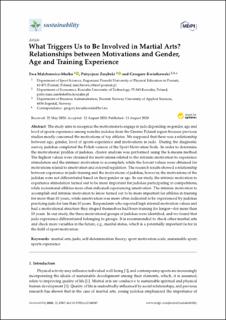| dc.contributor.author | Malchrowicz-Mosko, Ewa | |
| dc.contributor.author | Zarebski, Patrycjusz | |
| dc.contributor.author | Kwiatkowski, Gregory | |
| dc.date.accessioned | 2020-12-22T12:24:33Z | |
| dc.date.available | 2020-12-22T12:24:33Z | |
| dc.date.created | 2020-12-11T10:47:54Z | |
| dc.date.issued | 2020 | |
| dc.identifier.citation | Malchrowicz-Mośko, E., Zarębski, P., & Kwiatkowski, G. (2020). What Triggers Us to Be Involved in Martial Arts? Relationships between Motivations and Gender, Age and Training Experience. Sustainability, 12(16). | en_US |
| dc.identifier.issn | 2071-1050 | |
| dc.identifier.uri | https://hdl.handle.net/11250/2720784 | |
| dc.description.abstract | The study aims to recognize the motivations to engage in judo depending on gender, age and level of sports experience among nonelite judokas from the Greater Poland region because previous studies mostly concerned the motivations of top athletes. We supposed that there was a relationship between age, gender, level of sports experience and motivations in judo. During the diagnostic survey, judokas completed the Polish version of the Sport Motivation Scale. In order to determine the motivational profiles of judokas, cluster analysis was performed using the k-means method. The highest values were obtained for motivations related to the intrinsic motivation to experience stimulation and the intrinsic motivation to accomplish, while the lowest values were obtained for motivations related to amotivation and external regulation. The research results showed a relationship between experience in judo training and the motivations of judokas; however, the motivations of the judokas were not differentiated based on their gender or age. In our study, the intrinsic motivation to experience stimulation turned out to be more important for judokas participating in competitions, while recreational athletes more often indicated experiencing amotivation. The intrinsic motivation to accomplish and intrinsic motivation to know turned out to be more important for athletes in training for more than 10 years, while amotivation was more often indicated to be experienced by judokas practicing judo for less than 10 years. Respondents who reported high internal motivation values and had a motivational structure they shaped themselves had been training for longer—for more than 10 years. In our study, the three motivational groups of judokas were identified, and we found that judo experience differentiated belonging to groups. It is recommended to check other martial arts and check more variables in the future, e.g., marital status, which is a potentially important factor in the field of sport motivation. | en_US |
| dc.language.iso | eng | en_US |
| dc.rights | Navngivelse 4.0 Internasjonal | * |
| dc.rights.uri | http://creativecommons.org/licenses/by/4.0/deed.no | * |
| dc.subject | martial arts | en_US |
| dc.subject | judo | en_US |
| dc.subject | self-determination theory | en_US |
| dc.subject | sport motivation scale | en_US |
| dc.subject | sustainable sport | en_US |
| dc.subject | sports experience | en_US |
| dc.title | What Triggers Us to Be Involved in Martial Arts? Relationships between Motivations and Gender, Age and Training Experience | en_US |
| dc.type | Peer reviewed | en_US |
| dc.type | Journal article | en_US |
| dc.description.version | publishedVersion | en_US |
| dc.rights.holder | © 2020 by the authors. | en_US |
| dc.source.pagenumber | 1-14 | en_US |
| dc.source.volume | 12 | en_US |
| dc.source.journal | Sustainability | en_US |
| dc.source.issue | 16 | en_US |
| dc.identifier.doi | 10.3390/su12166567 | |
| dc.identifier.cristin | 1858657 | |
| dc.source.articlenumber | 6567 | en_US |
| cristin.ispublished | true | |
| cristin.fulltext | original | |
| cristin.qualitycode | 1 | |

